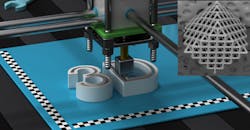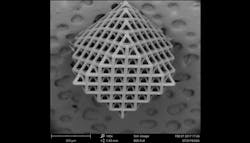3D-Printed Lattices Defy Conventional Wisdom on Structures
Lawrence Livermore National Laboratory (LLNL) researchers have designed a new class of 3D-printed lattice structures that are lightweight and highly stiff, a combination that is not supposed to be possible. The team used topology optimization software written by team member Seth Watts to create two unique small-unit cell designs. Both designs consisted of micro-architected trusses, and one was also supposed to have isotropic material properties, which means its mechanical properties were identical in all directions. These new trusses were then fabricated and tested, and found to outperform the octet truss, a standard geometric pattern for 3D-printed lattice structures.
The team was surprised that the trusses appeared to violate Maxwell’s criterion, a theory of structural rigidity used in mechanical design that says the most efficient load-bearing structures deform only by stretching. In such structures, stiffness scales linearly with density. So, cutting a structure’s weight in half will reduce its stiffness by half. Less-efficient structures would have their stiffness cut by three-quarters or seven-eighths if their weight was cut in half. This linear scaling lets engineers create ultra-lightweight, ultra-stiff mechanical metamaterials.
“It had been believed that Maxwell’s criterion was necessary and sufficient to show a structure had high stiffness at low density,” says Watts. “We’ve shown that it is not a necessary condition. In other words, there is a larger class of trusses that have this linear scaling property. It also shows that what was the previous orthodoxy is not firm. And there are exceptions that can get you better properties.”
Scanning electron microscopy images of a classic octet lattice and topologically optimized, isotropic oblate and quasi-spherical octahedral lattice built with a projection micro-stereolithography 3D-printing technique.
The two trusses were 3D printed using projection micro-stereolithography, which uses light projected onto a photosensitive polymer resin to build objects layer-by-layer. They were supposed to be perfectly isotropic so that their mechanical responses were the same regardless of where a load is applied. The designs were then validated experimentally.
The researchers said that these isotropic lattices can be placed arbitrarily with respect to known or unknown loads , thanks to their uniform responses. This means engineers can create stiffer structures than those built with other types of trusses such as the octet design, which is also is ultra-stiff but only in certain directions.
“The isotropic truss lets you disregard the load direction,” says Chris Spadaccini, director of LLNL’s Center for Engineered Materials and Manufacturing. “For example, you would no longer have to worry about what angle the loads are coming from. This work really shows that there’s a new method that can get you better performance, but has not been explored because it violates conventional wisdom.”
Researchers say the work also proves that using topology optimization lets engineers design structures that outperform those created with traditional “design-by-rule” approaches.
The work is part of an ongoing effort at LLNL to use computational approaches to improve the design of 3D-printed parts. The isotropic trusses were designed entirely through computer modeling. The new designs, as well as the algorithms used to develop them, are being incorporated into the Livermore Design Optimization (LiDO) code to make these advancements available to others researchers at the lab.
The researchers say the isotropic trusses could be extended into 3D-printed metals and ceramics and prove useful wherever stiff-yet-lightweight material is needed, such as in biological applications like 3D-printed tissues, where tunable stiffness is essential. The aerospace field also demands these properties. In a drone or fighter jet, for example, reducing structural weight increases maneuverability and reduces inertial forces, which would improve its performance.
Lightweight designs could also reduce production costs, fuel use, and material waste, and have a host of other benefits as engineers move toward more optimized structures.
The LLNL team is developing a fuller understanding of lattice structures, considering characteristics besides stiffness and density to include heat transfer, nonlinear mechanics, vibration, and failure.


